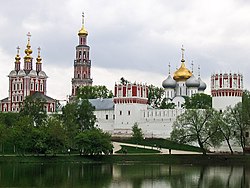Novodevichy Convent

Novodevichy Convent in summer
|
|
| Monastery information | |
|---|---|
| Order | Russian Orthodox Church |
| Established | 1524 |
| People | |
| Founder(s) | Vasili III of Russia |
| Site | |
| Location | Moscow, Russia |
| Coordinates | 55°43′34″N 37°33′22″E / 55.72611°N 37.55611°ECoordinates: 55°43′34″N 37°33′22″E / 55.72611°N 37.55611°E |
| Official name | Ensemble of the Novodevichy Convent |
| Type | Cultural |
| Criteria | i, iv, vi |
| Designated | 2004 (28th session) |
| Reference no. | 1097 |
| State Party | Russian Federation |
| Region | Europe and North America |
Novodevichy Convent, also known as Bogoroditse-Smolensky Monastery (Russian: Новоде́вичий монасты́рь, Богоро́дице-Смоле́нский монасты́рь), is probably the best-known cloister of Moscow. Its name, sometimes translated as the New Maidens' Monastery, was devised to differ from an ancient maidens' convent within the Moscow Kremlin. Unlike other Moscow cloisters, it has remained virtually intact since the 17th century. In 2004, it was proclaimed a UNESCO World Heritage Site.
The Convent is situated in the south-western part of the historic town of Moscow. The Convent territory is enclosed within walls and surrounded by a park, which forms the buffer zone. The park is limited by the urban fabric of the city on the north and east sides. On the west side, it is limited by the Moscow River, and on the south side there is an urban freeway. The buildings are surrounded by a high masonry wall with 12 towers. The entrances are from the north (town side) and the south. The layout of the convent territory is an irregular rectangle stretching from the west to east.
The oldest structure in the convent is the six-pillared five-domed Smolensky Cathedral, dedicated to the icon Our Lady of Smolensk. It is situated in the centre of the axes between the two entrance gates. Extant documents date its construction to 1524–1525; yet its lofty ground floor, magisterial proportions, and projecting central gable are typical of monastery cathedrals built at the behest of Ivan the Terrible. Most scholars agree that the cathedral was rebuilt in the 1550s or 1560s. It was formerly ringed by four smaller chapels, in an arrangement reminiscent of the Annunciation Cathedral in the Kremlin. Its frescos are among the finest in Moscow.
The cathedral may be a focal point of the convent, but there are many other churches. Most date from the 1680s, when the convent was thoroughly renovated at the behest of the regent Sofia Alexeyevna (who, ironically, would be incarcerated there later). The blood-red walls and crown-towers, two lofty over-the-gates churches, a refectory, and residential quarters were all designed in the Muscovite Baroque style, supposedly by a certain Peter Potapov. In the old cathedral, a new bowl for holy water and gilded carved iconostasis were installed in 1685. Its four tiers contain 16th-century icons endowed by Boris Godunov; the fifth tier displays icons by leading 17th-century painters, Simeon Ushakov and Fyodor Zubov.
...
Wikipedia
